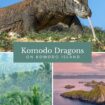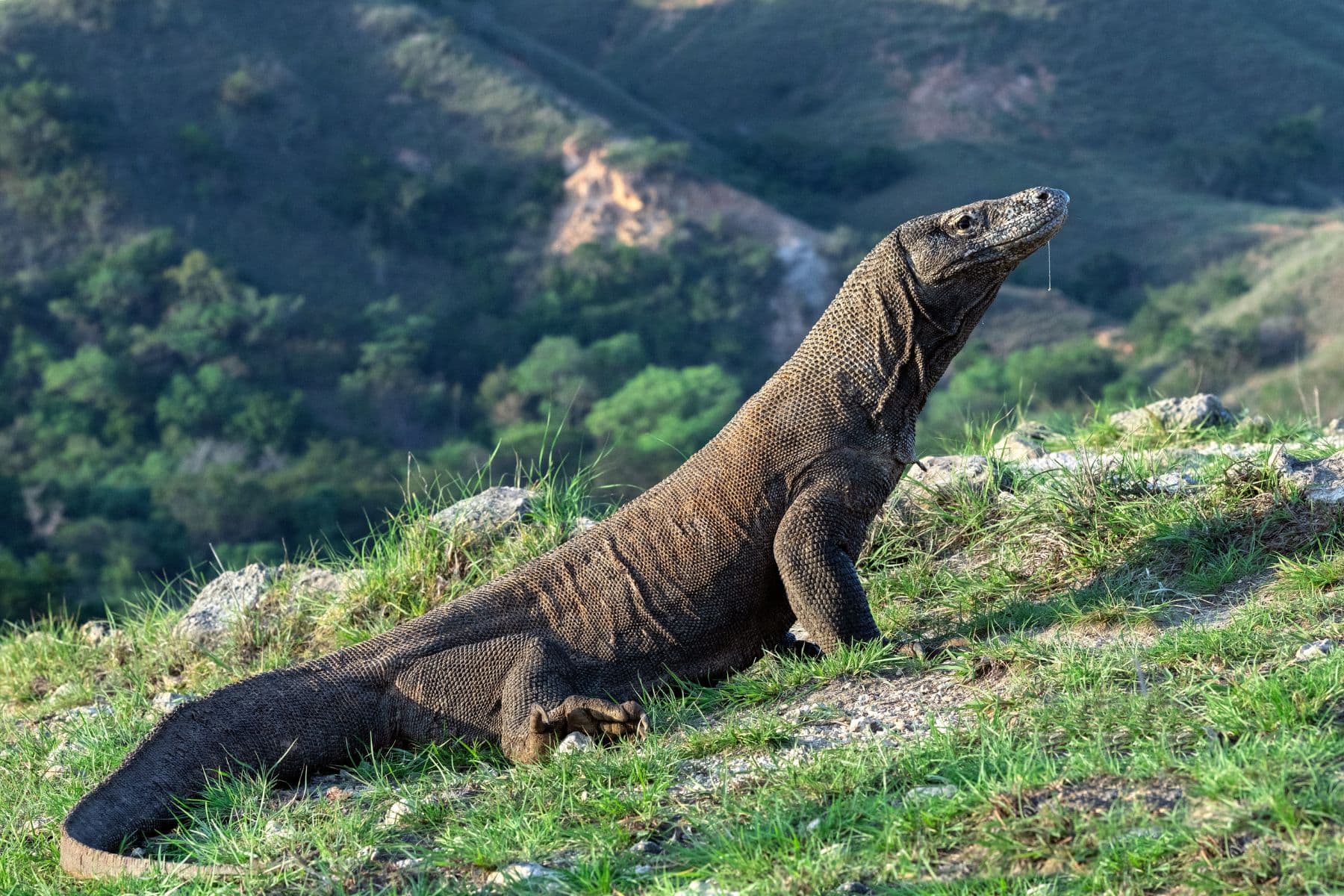
Go World Travel is reader-supported and may earn a commission from purchases made through links in this piece.
Waking Up the Komodo Dragons
As I crouch down, the plastic bag in my pocket crinkles loudly. The five creatures I am observing suddenly wake from their slumber and several pairs of eager eyes look in my direction, each one apparently questioning: Are you food?
I am in little danger, but I stay perfectly still, shocked at such an impressionable first view of these ancient creatures.
About 25 feet (8 m) away lie five Komodo dragons; while they do not breathe fire, they are the largest lizards in the world.
They are every bit as fearsome as their mythical namesakes: fierce, inch-long (2.5 cm) claws curled into the dirt, sharp eyes, a long, stocky body with a whip-like tail and a long, forked yellow tongue in a ferocious mouth, dripping saliva.
While four quickly return to sleep, realizing dinner is not on the menu, one stirs.
What Do Komodo Dragons Look Like?
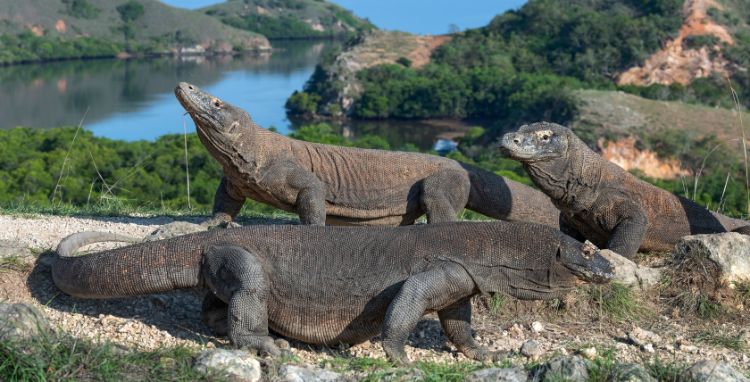
It pushes up its long, scaly body with its squat, muscular limbs and takes short, lumbering steps toward me.
Its leathery skin hangs in folds under its neck and limbs, peeling in large gray flakes.
Its tail sways in turn with its head, as if it is slowly scanning the area; its forked tongue laps the air. Black eyes, ringed by a hint of yellow scales, seem to stare straight through me.
Read More: Explore The Magic of Indonesia on a Luxury Cruise
Where Do Komodo Dragons Live?
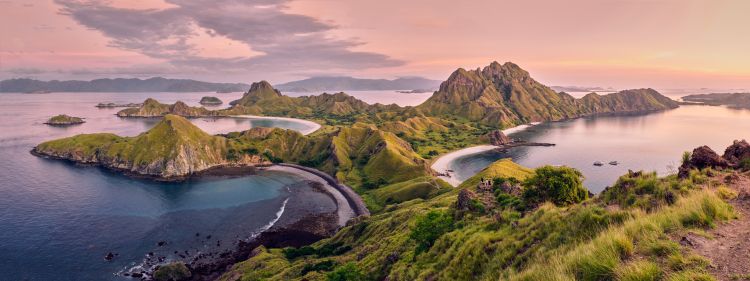
Komodo dragons inhabit just a few small islands in the center of Indonesia, with Komodo Island and Rinca Island having the largest populations, approximately 1,700 and 1,300, respectively.
Early morning is the best time to watch the dragons, as once the temperature rises they become lethargic and seek shade, either in the forest or in their burrows.
“Please, this way,” says Silva, our guide, who gently pulls me away from the approaching creature.
He stands at my side with a forked stick held out in front of him, our only protection should the Komodo fancy a quick snack.
How Dangerous Are Komodo Dragons?
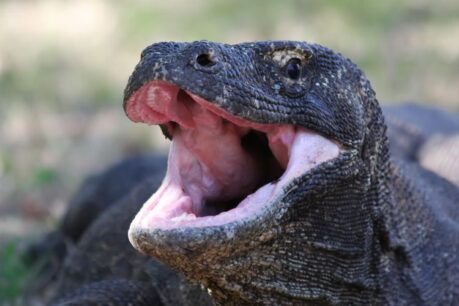
While Komodo dragons present little danger to humans, the locals are still wary in their presence.
A vice-like jaw contains jagged teeth, and their mouths can carry more than 50 different kinds of bacteria.
Without treatment, the smallest bite would quickly lead to septicaemia, but deaths are rare. “The last was about 10 years ago when a ranger went missing.
All they found was his watch,” says Silva.
A Komodo dragon’s regular diet consists of deer and wild pig, but it will also feast on water buffalo, wild horses, small lizards and birds, or even its own young.
The islands of the Komodo National Park are some of the few habitats where lizards, and not mammals, are top of the food chain. The wildlife on Komodo is unique.
Komodo’s Nest
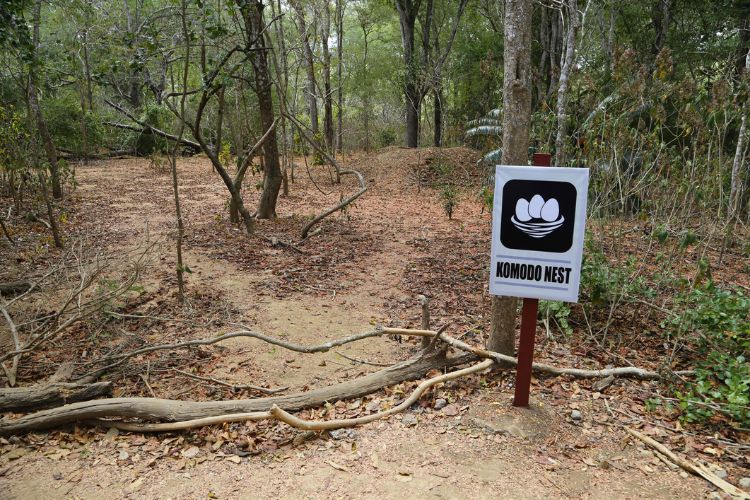
As Silva guides us away from the rangers’ station, he shows us several false tunnel entrances into an underground Komodo nest made by the mother to confuse other dragons that are keen to enter for an easy meal.
Once hatched, the baby dragons scurry into the trees for their first year of life, to avoid the cannibalistic jaws of their relatives.
Only when they are large enough to hunt — at around 29 inches (.75 m) long — will they descend to the forest floor.
We spot an approximately 3-year-old youngster trundling through the forest; with its smaller size and green-and-yellow speckling — which it gradually loses with age.
It is a less fearsome creature than those we have just seen, but nonetheless dangerous.
Komodo dragons can smell prey up to five miles (8.5 km) away. “They see very badly and cannot hear well,” Silva says, “but he will still be able to smell you when we have finished our walk.”
Read More: Visiting Bali: What You Should Know
Walking Through the Monsoon Forest
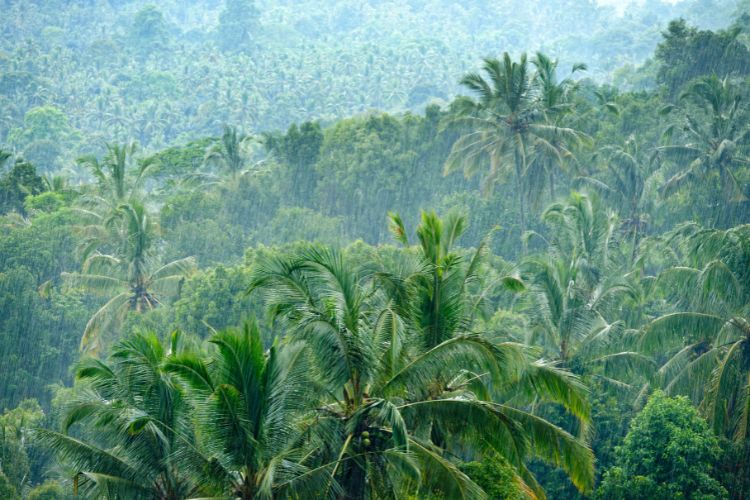
We continue to walk through the monsoon forest, a mix of coniferous and deciduous woodland, the most distinctive of which is the lontar palm, towering some 30 feet (9 m) above the rest of the foliage.
Several palms have recently died off after flowering, and they leave behind a canopy of thin gray branches as if the tree has been pulled up and thrust into the ground upside down.
Tamarind and jujube trees are alive with a rainbow of colorful birds: cockatoos, imperial pigeons, megapodes and collared kingfishers.
The contrasting flora and fauna seem appropriate for an island with prehistoric inhabitants.
Once we reach higher ground, the forest thins out into savannah grassland, with an occasional palm and small shrubs.
The Largest Komodo Dragon We See
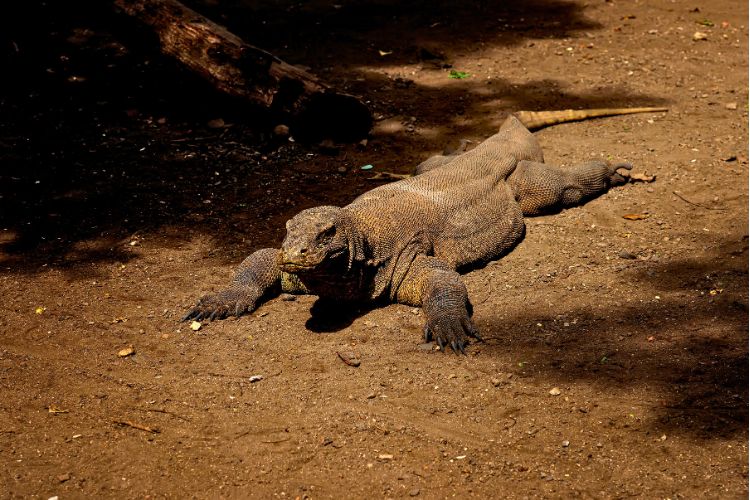
Lying under a nearby tree is the largest Komodo dragon we have seen, almost 10 feet (3 m) long, with a huge girth; it has recently eaten.
“They can eat almost their whole weight in one meal. I don’t think he will eat for a while,” says Silva, indicating two deer grazing close by.
Komodo dragons rely on surprise to bring down their prey, which can include animals as large as water buffalo.
Hiding in long grass or thick forest cover, a Komodo will try to bring a victim to the ground with a whip of its tail, then it will bite the prey. The Komodo’s deadly bite leads to a slow and painful death.
Dozens of dragons converge on the corpse once it succumbs to the poison, about a week later.
What Do Komodo Dragons Eat?
They often fight over food, but their thick skin protects them against an opponent’s claws, and dragons are not affected by another’s bite.
Using its claws, the Komodo usually begins by eviscerating the animal and consuming its entrails.
When Komodos feed they ingest the entire animal; skin, bones, hooves and even antlers will be consumed. There will be little evidence left when they are finished feeding.
Fossils resembling Komodo dragons have been found that date back 30 million years, and it is thought that they once roamed over much of maritime Southeast Asia.
While they are not descended from dinosaurs as is often assumed, research has suggested their ancestors date back anywhere from 50 to 200 million years.
We walk to the top of a nearby hill, the remains of an ancient volcano that created the island.
From here we see the home of an entire species: a few small islands ringed with mangroves, white sands and coral reefs.
These islands sit atop the Sahul and Sunda continental shelves; this is an active seismic area.
While at the moment there are no active volcanoes in the area, with an entire species occupying such a small area, a single eruption could easily see these prehistoric creatures go the way of their Jurassic family.
If You Go
- Indonesia Tourism – Komodo Island
Read More:
- What It’s Like to Live as an Expat: Lake Chapala, Mexico - April 18, 2024
- Top 5 Spots for Stargazing in North Carolina - April 17, 2024
- The Low-Key Magic of Ghent, Belgium - April 17, 2024

